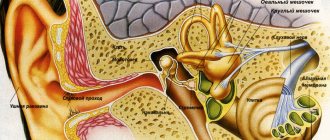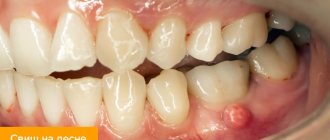08/25/2021
130 450
7 minutes
Author, editor and medical expert – Klimovich Elina Valerievna.
Fever with sore throat (acute tonsillitis) is the same characteristic symptom as a sore throat. But sometimes the temperature is high, and the sore throat is not very pronounced1. Because of this, people do not treat the disease, but simply try to “bring down” the temperature - this is unsafe1,3. What determines the temperature level during tonsillitis, and what needs to be done to alleviate the condition?
Before finding out what temperature happens with a sore throat, you need to figure out what is considered a normal temperature and what is not.
In children and adults, the morning temperature measured in the armpit should be less than 37.20C2. In the evening, the temperature is allowed to rise to 37.70C - this is normal, especially for children2. Anything higher is considered to be fever2.
Up to contents
Features of the disease
The peripharyngeal ring is a collection of lymphoid tissue, which is an important peripheral organ of the body's immune system. Pathogenic microorganisms that enter the body with food and water are retained in the oral or nasal cavity precisely by the tonsils of the peripharyngeal ring. As a result of the struggle between the body and the infectious agent, a local reaction of the tonsils occurs, which is expressed in increased production of lymphocytes and can lead to tissue inflammation.
Inflammation of the tonsils can also be caused by an internal infection of the body, namely diseases of the oral cavity or ENT organs: caries, sinusitis, rhinitis, otitis media, etc. When the body's immune defense is weakened due to illness or hypothermia, opportunistic microflora found in the growth or nasal cavity can provoke acute inflammation of the tonsils. Factors that provoke pathology are bad habits (smoking and alcohol abuse), diseases of the gastrointestinal tract, working in hazardous working conditions, and unhealthy diet.
The risk group for the disease includes pregnant women, the elderly and children, as well as people with chronic damage to the immune system.
Systemic complications
When a sore throat develops, an adult should always remember that failure to comply with treatment can lead to damage to:
- Hearts
. Sore throat often causes myocarditis and rheumatic damage to the heart muscle. Symptoms of complications may appear after 2-3 weeks. The main signs are arrhythmia, the appearance of increasing shortness of breath, swelling of the limbs, weakness, heart pain, and increased sweating. - Kidney
. The most likely complications of tonsillitis from the kidneys are pyelonephritis and glomerulonephritis. Renal pathologies are indicated by pain in the lumbar region, increased urination, swelling of the face and legs, lethargy, and irritability. - Sustavov
. After a sore throat, the possible development of rheumatoid arthritis. Symptoms are swelling and pain in the joints, redness of the skin where the limbs are flexed.
The most serious complications of tonsillitis are sepsis and toxic shock. They develop when bacteria spread throughout almost the entire body. The diseases are manifested by severe symptoms of intoxication, shortness of breath, difficulty breathing, and severe weakness. Treatment is carried out in intensive care conditions.
Classification of the disease
Inflammatory pathology of the tonsils varies:
- by type of pathogen, can be bacterial, viral or fungal in nature;
- by the nature of the course - acute or chronic;
- according to the clinical picture - catarrhal, follicular or lacunar.
Sore throat can be primary (simple), which occurs when a bacterial infection penetrates, secondary, which occurs against the background of other diseases of the body, and also specific, caused by the action of a specific agent.
Prevention of complications after tonsillitis
To prevent the development of life-threatening complications, the patient should:
- Start drug therapy as early as possible from the onset of the disease.
- Use medications prescribed by your doctor for treatment. Antibiotics are prescribed to each patient individually, taking into account the sensitivity of pathogenic microorganisms to antibacterial agents.
- During the period of rising temperature, strictly adhere to bed rest.
- Drink as much as possible. Drinking large amounts of water and unsweetened compotes accelerates the removal of microbes and their toxins from the body.
If you have complications after a sore throat, you can contact our clinic for treatment. Qualified doctors will not only conduct a thorough diagnosis and identify the slightest undesirable changes, but will also correctly select medications taking into account the type of pathogenic microbes, the patient’s age and concomitant diseases.
After the main therapy, the clinic’s doctors also give their patients a list of recommendations, compliance with which will minimize the negative impact of tonsillitis on the body.
Symptoms of the disease
Sore throat or acute tonsillitis have a pronounced clinical picture. The incubation period lasts from 12 to 48 hours, after which clinical signs appear.
- Increased body temperature (above 39°C, less often 37-38°C). With a sore throat, it is difficult to lower a high body temperature with the help of antipyretics.
- Signs of intoxication are body aches and weakness, headache, chills, dizziness, pain in the chest and heart area.
- Pain and sensation of a lump in the throat. Pain when swallowing.
- Hoarseness of voice.
- Inflammation of regional lymph nodes.
On examination, swelling and hyperemia of the palatine tonsils are revealed. Depending on the type of inflammation, purulent plaque forms on the lacunae or all tonsils.
In some cases, the symptoms of the disease may not be expressed. The temperature may remain within the low-grade range or slightly elevated, accompanied by unpleasant and painful sensations in the throat.
Local complications
The development of local complications of tonsillitis, covering the ENT organs and respiratory system, is indicated by the addition of new symptoms, deterioration of health against the background of the beginning of recovery.
The most likely consequences of a sore throat are:
- Peritonsillar abscess
. This is the formation of an abscess in the tissue of the pharynx. It is manifested by the appearance of increasing pain on one side of the throat, a secondary increase in temperature, tension in the neck muscles, and difficulty swallowing. The patient cannot turn his neck normally and open his mouth completely. - Otitis
is an inflammation of the middle ear. It occurs both in parallel with a sore throat and a few days after the completion of the acute stage of tonsillitis. - Swelling of the larynx
. Occurs due to inflammation of the vocal cords. It manifests itself as hoarseness, difficulty swallowing and deterioration in breathing. - Inflammation of the lymph nodes
. The submandibular ones are most often affected, less often the clavicular and supraclavicular, cervical ones. - If left untreated, tonsillitis can also cause bronchitis, pneumonia, and tracheitis.
Treatment of the disease
In most cases, treatment is carried out on an outpatient basis. Patients are prescribed bed rest, warm, plenty of fluids, and food should be light and liquid. Treatment, depending on the type of sore throat, includes antibacterial therapy, antiviral drugs and local symptomatic treatment. Additionally, the tonsils are irrigated with anti-inflammatory drugs, gargling with herbal decoctions and antiseptic solutions. To reduce swelling and symptoms of intoxication, antihistamines are indicated. The course of treatment is 5-10 days.
Types of edema.
There are several types of Quincke's edema.
Angioedema can be hereditary or acquired. Hereditary angioedema is a rare genetic disease that was first described at the end of the 19th century and is characterized by recurrent edema. If a mother or father has this diagnosis, the probability that their child will be born with the same diagnosis is 50%. With timely prevention and proper treatment, the patient’s attacks rarely occur, and the patient lives quite well with this diagnosis. Cases of acquired disease are quite small, and are most often observed in elderly patients.
Depending on the cause that caused Quincke's edema, allergic, non-allergic and idiopathic edema are distinguished when the cause of the condition could not be determined.
Complication of the disease
Sore throat is dangerous because of its complications, which can be early, i.e. occurring immediately after inflammation of the tonsils or delayed, which appear 3-4 weeks after purulent inflammation. Complications can be single (affect one organ) or multiple and affect several organs.
Early complications of tonsillitis are otitis media, lymphadenitis, sinusitis, sinusitis, laryngeal edema, tonsil abscess, etc. Delayed inflammation provokes diseases of the heart muscle (rheumatism of the heart muscle, myocarditis, pericarditis), joint pathologies (rheumatism, arthritis), kidney diseases (glomerumetritis, pyelonephritis, renal failure).
In medical clinics, at any time convenient for you, they will provide timely and qualified assistance for any diseases of the ENT organs in patients of all age categories. The clinics are equipped with modern diagnostic equipment for diagnosing ENT diseases, and patients also have a modern diagnostic laboratory at their disposal, in which all necessary laboratory tests are performed.
Our otorhinolaryngology doctors have extensive experience in diagnosing and treating various diseases of the ear, nose and throat in adults and children, using both conservative and surgical methods. When the first symptoms of a sore throat or other pathologies appear, do not delay visiting a doctor and seek qualified medical help. You can make an appointment by calling the center or leaving a request on the website.
Treatment of angioedema of the larynx.
Treatment of angioedema consists of two stages. The first is emergency care, the second is hospital treatment. Before starting treatment, the cause of angioedema is determined, and then a treatment regimen is prescribed. This may include:
- taking antihistamines (“Suprastin”, “Loratadine”, “Tavegil”);
- corticosteroid drugs (for example, Prednisolone, Dexamethasone, Nasonex, Celeston);
- diuretics (for example, Furosemide);
- enterosorbents for removing allergens and toxins (for example, Multisorb);
- enzyme preparations (“Pancreatin”, “Festal”);
- administration of a C1 inhibitor, a blood protein whose deficiency leads to non-allergic angioedema;
- administration of fresh frozen plasma (for non-allergic edema);
- administration of androgens - sex hormone preparations (for non-allergic edema).
Fever as an indicator of the severity of sore throat
The level of fever in sore throat is related to the nature of the infection, the severity of inflammation and the general condition of the body1.
- With a mild course of acute tonsillitis, the temperature is subfebrile (up to 38.50C) and does not last longer than 2-3 days. The sore throat is insignificant, the general condition suffers little - slight weakness and drowsiness may be noted. Sore throat is more often catarrhal, that is, it is limited to redness and swelling of the tonsils.
- Symptoms of follicular tonsillitis and a temperature of 38.5-390C in an adult indicate a moderate course of the disease . Fever lasts 4-6 days, accompanied by severe weakness, chills, headache, aches in muscles and joints, indicating significant intoxication. Severe pain in the throat when swallowing. The tonsils are red, enlarged in size with a scattering of pus-filled follicles or purulent deposits. The cervical lymph nodes enlarge up to 2 cm and become painful when touched.
- In severe tonsillitis, the fever reaches 390C or higher. Intoxication is severe, sometimes it leads to functional disruptions in the functioning of the heart and kidneys. The sore throat becomes constant, squeezing the throat. Lymph nodes reach a size of 3 cm. Complications often develop, such as peritonsillar abscess and otitis media.
Fever can be one of the first symptoms of a sore throat. Thus, with streptococcal tonsillitis, fever up to 390C, chills, headache first appear, and only then, after 2 days, sore throat and other symptoms typical of inflammation of the tonsils1.
The level of temperature rise depends on age. Thus, due to physiological characteristics in young children and the elderly, the febrile reaction may be less pronounced than in young people1,3. High numbers on the thermometer should not be expected either in patients with weakened immune systems3.
Up to contents









